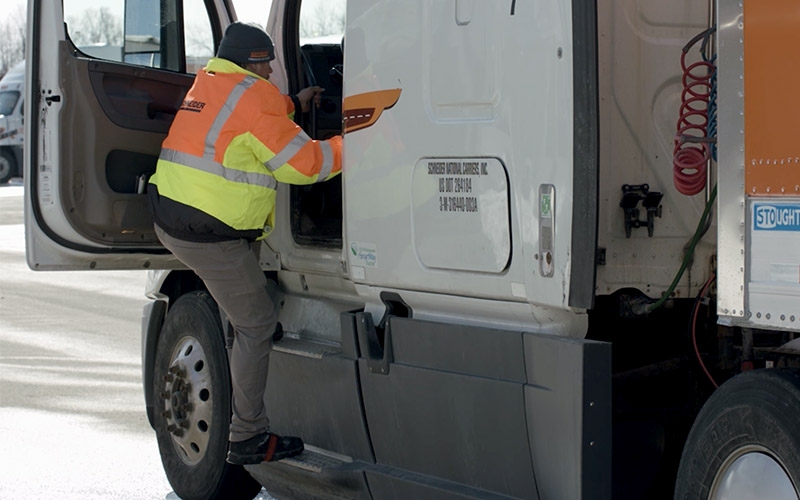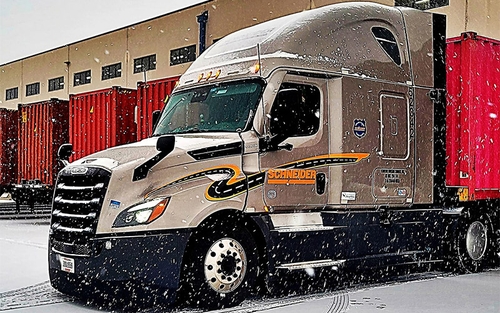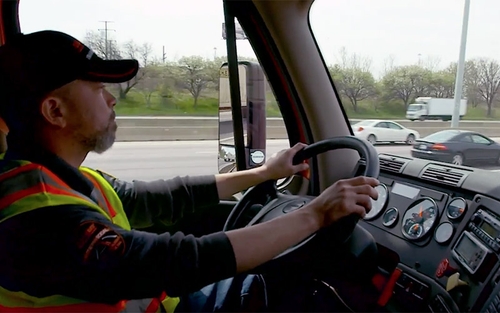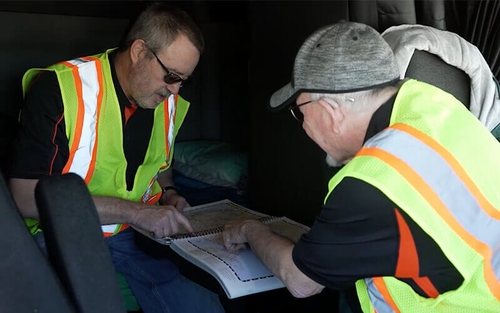16 essential safety tips for truck drivers to know


By The Schneider Guy
Estimated reading time: 4 minutes
Being a successful and safe truck driver doesn’t end when you get your CDL. Having a safety mindset is vital no matter where you’re at in your driving career.
To refresh your knowledge when it comes to truck driver safety, we created a list of 16 essential tips for truck drivers. No matter how much driving experience you have, the following tips can be great reminders.
Pre-trip: 5 truck driver safety tips to follow before you hit the road
1. Take care of yourself.
The most important asset in the truck is you, so be a healthy truck driver by following these tips:
- Focus on getting better sleep on the road.
- Incorporate exercise and stretching into your routine.
- Cook healthier meals in your truck.
- Invest in items like sunshade covers and a seat cushion.
2. Trip plan with care.
Before hitting the road, make sure you’re up to date on:
- Weather.
- Road conditions.
- Traffic patterns.
- Construction.
- Low bridges.
- Driving regulations.
This is just one of the many trip planning tips truck drivers should consider.
3. Prepare a truck driver emergency kit.
Having an emergency kit in your truck at all times keeps you prepared for emergencies like bad weather, accidents or personal health problems. Make sure to tailor your kit to what type of driver you are, what freight you haul and what climate you drive in.
Consider purchasing a pre-made kit online, or making your own.
4. Get comfortable.
Adjust the steering wheel, seat height and seat back to ensure you will stay comfortable during your drive. Also, get your GPS ready before you turn the key.
Plan to take a break every few hours. When taking your break, park in a safe spot (not on the shoulder) and get out to walk around.
5. Use three points of contact when entering and exiting your truck.
When getting in and out of your tractor, always maintain three points of contact. Slips, trips and falls are common causes of injury, so don’t risk it by rushing.
Set food, beverages, paperwork or other items on your seat or floor so both hands are free to maintain a firm grip while getting out of your truck.
On the road: 6 truck driver safety tips for while you drive
6. Take time changing lanes.
Complete a safe lane change by using the “Take 10” method:
- Check and double-check your mirrors and blind spots to ensure there is enough room for you to get over.
- Signal for at least three seconds to make your intentions clear to other drivers.
- Take at least seven seconds to complete your lane change (while keeping an eye on your mirrors and continuing to check the lane you are moving into to make sure it is still safe to pull into that lane).
- Be as predictable as possible with your movements.
7. Pay extra attention to work zones and school zones.
Roughly one-third of all fatal work-zone accidents involve large trucks.
When driving in these situations:
- Slow down and be prepared to stop at any time.
- Leave extra space in front of you to account for changing traffic patterns.
- Scan ahead and check your blind spots for workers, machinery and uneven roads.
- Pay extra attention to signs and flaggers.
These are just a couple of the important tips for driving safely in construction zones.
8. Be predictable and take it slow.
Driving in a predictable way keeps both you and the motoring public safe. You can do this by:
- Using your turn signals well in advance.
- Leaving your blinkers on until the turn or lane change is completed.
- Turning your headlights on half an hour before dusk and leave them on until half an hour after sunrise to make sure you’re as visible as possible to other drivers.
9. Maintain your distance.
Keep a safe distance of seven to eight seconds between you and the vehicle in front of you at all times, since large trucks require more stopping and following distance.
In bad weather, increase your distance to as much as 14 seconds or more.
10. Stay focused on driving.
Some tips for staying alert while driving long distances are:
- Never use the phone while driving.
- Turn off the radio in heavy traffic, bad weather or poor conditions.
- Limit distractions while driving by setting your GPS and eating before you start your engine.
- Practice good sleeping habits.
11. Stay alert of your surroundings.
Scan your surroundings to stay alert of any potential obstacles around you. You can do this by:
- Knowing the "no-zone" blind spots, and exercising caution before turning or changing lanes to maintain a safe distance.
- Looking ahead 15 seconds, scanning for drivers around you and leaving plenty of room for their actions.
- Checking your mirrors every three to five seconds, and maintaining a good scan pattern by looking at your west coast mirrors, your hood mirrors, the road ahead and your gauges.
Destination: 5 truck driver safety tips for once you arrive
12. Get Out And Look.
Don’t be afraid to G.O.A.L – Get Out And Look – as many times as you need when backing into a parking spot or dropping a load at a dock. It’s better to take the time you need to complete the back correctly than to cause an accident that could have been prevented.
Many times, when you go to park, the truck that was in the spot before left a perfect path of tire tracks. Try to aim your tires for that path.
13. Inspect the location you will be parking in.
Park, then get out and inspect the area in which you’ll be parking, unloading or coupling up to a new trailer.
14. Use caution while working with landing gear.
To reduce the risk of injury when raising or lowering your trailer’s landing gear:
- Always wear your gloves.
- Position your feet firmly for balance and watch out for slippery or uneven ground surfaces.
- Place the hand not used for turning the dolly handle against the side of the trailer to help maintain your balance.
- Hold the landing gear handle firmly and do not attempt to spin it.
- Keep your face clear of the landing gear handle at all times.
15. Unload freight wisely.
If you have a driving job that requires you to unload your freight, there are steps you should take to make sure you unload it safely.
Before opening your trailer doors, consider that freight may be resting against the door. Then:
- Slowly loosen the lock bars on the right-hand door, keeping your body adjacent to the left door.
- As the door starts to open, peek in the crack to see if there’s freight against the door.
- Once cleared, use both hands to swing the door to avoid wind catching it.
- Secure the door firmly with the tie-back cable or chain.
16. Inspect your truck.
Always perform a thorough post-trip inspection. You don’t want to discover a flat tire with a nail in it, a fluid leak or a burnt-out trailer light later when you get ready to drive again. Make sure you record and report any defects to your leader.
Get more expert driving tips and guides.

Schneider Guy loves the "Big Orange." He's passionate about the trucking industry and connecting people to rewarding careers within it. He's been the eyes and ears of our company since our founding in 1935, and he's excited to interact with prospective and current Schneider associates through "A Slice of Orange."



